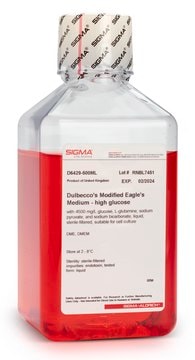The FBS should be stored at the recommended temperature of -20°C. Storage at -80°C has not been tested, but there are no anticipated issues. Frost Free Freezers should be avoided for storage.
F4135
胎牛血清
USA origin, Heat Inactivated, sterile-filtered, suitable for cell culture, suitable for insect cell culture, suitable for hybridoma
别名:
HI FBS, HI FCS, HI 血清, FBS, FCS, 血清
选择尺寸
About This Item
推荐产品
一般說明
應用
準備報告
分析報告
- 内毒素和血红蛋白测试
- 检测了是否存在细菌、病毒和支原体
- 在无菌条件下用0.1微米膜过滤三次
也與該產品經常一起購買
儲存類別代碼
10 - Combustible liquids
水污染物質分類(WGK)
WGK 3
閃點(°F)
Not applicable
閃點(°C)
Not applicable
個人防護裝備
Eyeshields, Gloves
商品
Calcium is an ionically stable divalent cation with important beneficial and toxic properties in cell culture. It is a component of a wide range of cell culture media.
钙是一种离子稳定的二价阳离子,在细胞培养基中具有有益和有毒的双重属性,可作为一系列细胞培养基的组成部分。
回顾使用胎牛(或小牛)血清进行细胞培养的基础知识,以及采购和法规如何影响细胞测定所用血清的价格。
Review the basics of using fetal bovine (or calf) serum for cell culture and how sourcing and regulations affect the price of sera for cell-based assays.
实验方案
Protect your investment with best practices for storing and thawing FBS and other sera. Sample FBS for validation in your cell culture protocol.
相关内容
Learn how to effectively filter fetal bovine serum (FBS) using Stericup® Quick Release vacuum filtration devices, including flow test data and analysis.
我们的胎牛血清(FBS)系列可供您寻找适合实验室需求和预算的FBS。索取血清样品。
Explore our portfolio of fetal bovine serum (FBS) and determine the right FBS for your lab needs and budget. Request a serum sample.
-
Is it possible to store the FBS at a temperature of -80°C, which is lower than the recommended storage temperature of -20°C?
1 answer-
Helpful?
-
-
Recommended storage is listed as -20C; is it safe/ok to store at -80C?
1 answer-
The recommended long-term storage temperature for FBS is -20C. For the short-term, such as for shipping, packing on dry ice at -40C is recommended. It is not recommended to store the FBS at temperatures lower than -40C. Please see the guide on freezing and thawing FBS and other sera below:
https://www.sigmaaldrich.com/technical-documents/protocol/cell-culture-and-cell-culture-analysis/cell-culture-media-preparation/storing-and-thawing-serumHelpful?
-
-
Once a bottle of Fetal Bovine Serum (FBS) is thawed, for how long can the bottle be used?
1 answer-
Once Fetal Bovine Serum has been thawed, the bottle can be used in cell culture for up to 7 days for most cell types when stored refrigerated at 2-8°C. If the cells are not fastidous (e.g. HeLa or fibroblasts), the thawed and refrigerated serum can be used for up to 30 days. For some extremely fastidious cell lines, it may be necessary to screen individual lots for acceptable performance. For uses such as blocking for various immuno procedures, usage will generally be for 30 days and perhaps somewhat longer when stored at 2-8°C. For other procedures, usage beyond 30 days storage at 2-8°C will need to be determined.
Helpful?
-
-
What is the Department of Transportation shipping information for this product?
1 answer-
Transportation information can be found in Section 14 of the product's (M)SDS.To access the shipping information for this material, use the link on the product detail page for the product.
Helpful?
-
-
Why is serum Heat-Inactivated (HI)?
1 answer-
Heat inactivation of serum is performed to inactivate complement (which can cause cell lysis or downstream problems in immunoassays). If there are immunoglobulins present in the serum that can bind to the cells in culture (either specifically or non-specifically), there is a chance for antibody-mediated complement cytotoxicity (ADCC, causing cell death). It may also reduce the titer of some mycoplasma and some viruses. Often, heat-inactivated serum is used because of the adoption of a previous protocol. It is mainly used when culturing hematopoetic cells or performing immunological type assays such as mixed-lymphocyte reactions or neutralization assays.FBS may not be heat inactivated as this is not required for all applications. It limits the loss of the other protein activity that may be minimally present in the serum.A protocol for heat inactivation:1. Allow serum containers to come to room temperature. Swirl bottles of serum immediately before adding to the water bath.2. A water-filled control bottles (T1) should be placed in a 56 °C water bath. Place the containers in the water bath up to the serum line. Do not completely submerge the containers. When the temperature of T1 reaches 56 °C, start the timer set for 30 minutes. Do not allow temperatures to exceed 56 °C. Higher temperatures will denature the proteins, gel the serum or alter the performance of the serum.3. Gently swirl the bottles every 5 to 10 minutes while in the water bath and check the temperature in the control bottle. It is not uncommon for plastic containers to bow slightly after heat treatment. This is not harmful to the serum.4. At the end of 30 minutes remove the serum bottles from the water bath. Aliquot the serum into smaller volumes and freeze. Sigma-Aldrich does not recommend repeated thaw-freeze cycles.
Helpful?
-
-
Does Sigma-Aldrich offer delipidated bovine serum?
1 answer-
At this time, Sigma-Aldrich does not offer delipidated bovine serum (either FBS or calf serum).A method for lipid depletion, though not necessarily that of Sigma:1. While mixing, gradually add 10 g fumed silica (Product S5130 or Aerosil) per liter of serum2. Mix at room temperature and then transfer to 2-8 °C for overnight mixing.3. After overnight mixing, remove flumed silica (Aerosil) by centrifugation at 3000-5000 rpm for 5 minutes.4. Retain the supernatant. The lipids should stick to the silica. There may be some protein loss
Helpful?
-
Active Filters
我们的科学家团队拥有各种研究领域经验,包括生命科学、材料科学、化学合成、色谱、分析及许多其他领域.
联系技术服务部门





